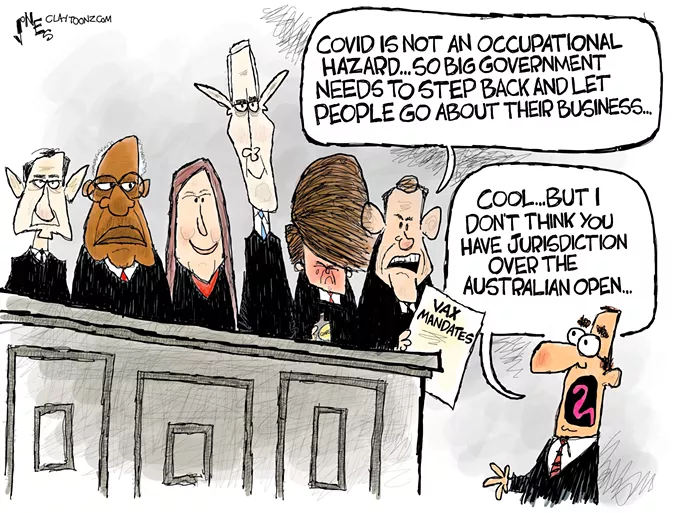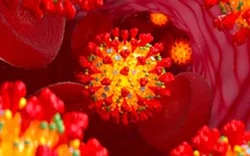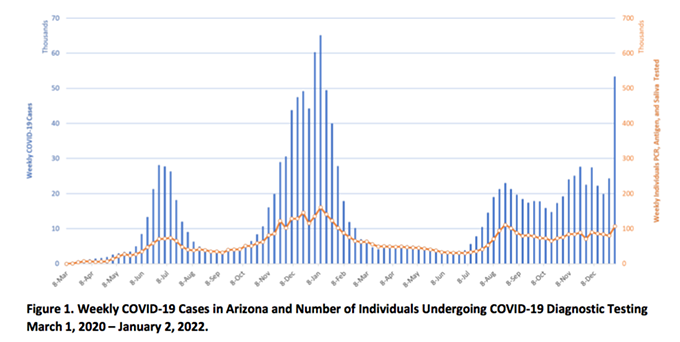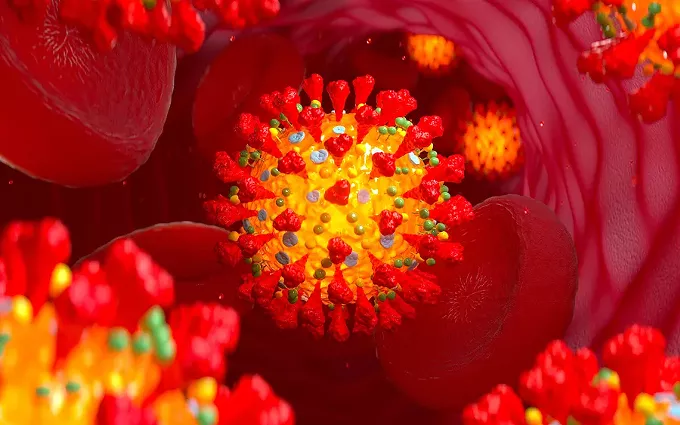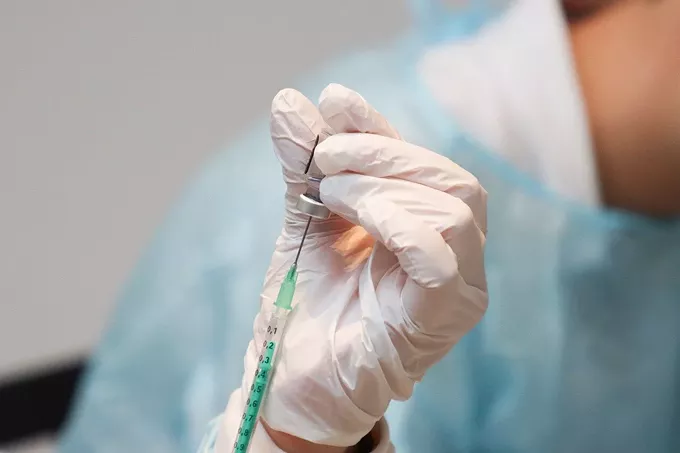Tuesday, January 18, 2022
WASHINGTON — The Biden administration on Friday launched a new website for Americans to request up to four free COVID-19 tests per household.
The administration is buying 1 billion at-home rapid COVID-19 tests, and Americans will be able to begin ordering the tests online on Jan. 19 at COVIDtests.gov.
This is part of the administration’s effort to curb the spike of the omicron coronavirus variant that has overwhelmed hospitals and schools.
Tests should ship via the U.S. Postal Service between seven and 12 days after they are ordered, senior administration officials said on a call with reporters.
“Testing is a critical tool to help mitigate the spread of COVID-19,” a senior administration official said.
The White House said tests should be used by individuals who begin to have COVID-19 symptoms; after five days of coming into close contact with someone with COVID-19; or if gathering indoors with someone who is at risk for a severe disease or is unvaccinated. Children 4 and under are not eligible for vaccines.
The initial 500 million tests are expected to cost $4 billion, a senior administration official said.
The Biden administration also announced that starting Monday, private insurance providers will cover the cost of up to eight at-home COVID-19 tests per person per month.
On Thursday, Biden said that in addition to free tests, Americans would also get free high quality masks.
The administration also aims to make sure members of some communities the hardest hit by COVID-19 will have a hotline they can access if they do not have internet access or have difficulty ordering tests online. The number to call for help is not available yet.
Friday, January 14, 2022
Thursday, January 13, 2022
Arizona reported 18,783 COVID-19 cases Wednesday, the latest in a surge of infections that experts say is stressing a state health care system that is “not well suited” to take on more cases.
The state has been averaging almost 12,000 new cases a day since Jan. 1, according to data from the Arizona Department of Health Services, as the new, more-contagious omicron variant has raced through the state. COVID-19 deaths in the state are averaging 64 a day this month, and totaled just under 25,000 Wednesday.
The rate of infection is “going up, and it’s going up fast,” stretching health care workers to their limit, said Dr. Josh LaBaer.
“We have fewer health care workers than we used to,” said LaBaer, executive director of Arizona State University’s Biodesign Institute. “There are empty beds but there is no one to staff the beds.”
Officials at Valleywise Health said the health care system has seen the number of COVID-positive patients in its emergency departments nearly double in the last month.
More than 25,000 Arizona have now died after contracting COVID-19.
The virus has killed 25,002 people as of today, including 3,273 in Pima County, according to the Arizona Department of Health Services.
The grim milestone came one day after the state reported a record 18,783 new cases of COVID-19 as the Omicron variant continues to rapidly spread across the state. The previous record was 17,234 cases, set on Jan. 3, 2021.
While Omicron appears to be less severe than the Delta variant, especially among vaccinated people, the surge of cases is still putting pressure on Arizona’s overwhelmed hospitals and ICU units.
This week, Dr. Marjorie Bessel, the chief clinical officer for Banner Health in Arizona, said the health network was seeing a steady uptick in admissions in recent weeks and healthcare workers are contracting the virus, leading to staffing crunches at Banner Health.
Tuesday, January 11, 2022
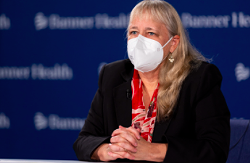
COVID hospitalizations are on an upward climb thanks to the Omicron variant and healthcare workers are contracting the virus, leading to staffing crunches at Banner Health.
As a result of the staffing crunch, some Banner urgent care locations are closed, causing longer wait times at other urgent care facilities, according to Dr. Marjorie Bessel, Banner Health chief clinical officer, who gave a media briefing on Tuesday, Jan. 11.
Banner’s staffing shortage reflects a national shortage of healthcare workers due to the surge of Omicron.
Banner is following the crisis CDC guidelines when allowing health care workers to return to work after being infected with the COVID virus. All healthcare workers have to remain out of the workplace for five days from the date of their positive tests and are screened for symptoms before returning to work process. Individuals that are asymptomatic and mildly symptomatic may return to work.
In addition, Banner is using outside contracted workers at its hospitals during this surge to compensate for the staffing shortage.
With crowded emergency rooms and long waits, Bessel said Banner is using ERs for life-threatening issues and asked Arizonans to consider primary care doctors and urgent care clinics for non-emergency needs.
She also urged Arizonans to get vaccinated and receive a booster shot because it’s “the best way to prevent serious COVID illness that requires hospital level care.” She also said people should mask up when indoors, preferably with a fitted KN95 mask, stay home when feeling sick and to get tested when experiencing symptoms.
COVID treatment options remain limited. Sotrovimab, a monoclonal antibody treatment for those who test positive, is in short supply and will require a doctor’s recommendation for patients. Due to limited supply, not all eligible patients will receive the treatment.
Oral antivirals such as paxlovid and molnupiravir, which have received emergency use authorization by the FDA for patients that meet the clinical requirements, are also in limited supply and are being distributed to roughly 32 retail pharmacies across the state. These medications also require a referral.
Bessel said Omicron has yet to peak but she predicted it will be in weeks to come based on how the virus has behaved in other countries, where the descent of the variant has been just as rapid as its spread.
“We continue to learn through the pandemic," Bessel said. “Banner Health, as we have been throughout the entire pandemic, continues to operate and evaluate our business on a day-to-day basis and will make appropriate responses based on the needs of our community.”
Correction: An earlier version of this story suggested all Banner Urgent Care clinics were temporarily closed. Only some of the clinics have temporarily closed.Saturday, January 8, 2022
In his latest weekly report , Dr. Joe Gerald, the UA epidemiologist who has been tracking Arizona's COVID outbreak since its earliest days, confirms Omicron is bringing skyrocketing COVID case numbers. A total of 53,207 Arizonans tested positive for COVID in the week ending Jan. 2, which was more than twice as many as the previous week. Along with that 120% increase, cases are being diagnosed at 731 per 100,000.
It's spreading especially fast among those 15 to 24 years of age, who are seeing rates of 1,005 cases per 100K, and lowest among those 65 and older, at 407 cases per 100,000, and those younger than 15, at 409 cases per 100,000. Those high numbers likely undercount the number of positive cases because not everyone who gets COVID will get a test.
Speaking of testing, positivity of those getting tested, which dipped down to the 8% range last summer, jumped to 50% and "remains inadequate for public health practice and many cases are going undiagnosed," according to Gerald.
While people tend to have less severe bouts with Omicron, hospitals are still facing huge pressure, particularly thanks to unvaccinated patients who make up the majority of those who end up hospitalized with COVID.
"While peak occupancy will not reach prior levels, the Delta, and now Omicron, waves have placed much higher levels of chronic stress on our health system," Gerald wrote. "We have so far seen 146 consecutive days with a combined occupancy >2000 patients whereas the summer 2020 and winter 2021 waves saw 57 and 98 days, respectively. Until last week, we had experienced 37 consecutive days with >3000 combined occupancy whereas the summer 2020 and winter 2021 waves saw 35 and 78 days, respectively. After a 10-day respite over Christmas-New Years, we are once again >3000 combined occupancy (last 4 days)."
Gerald—whose opinions are his alone, not those of the UA Zuckerman School of Public Health—says too many elected leaders are pursuing business-as-usual policies in the face of the wave and “the outcome will be more death and disability than necessary, more death and disability than others in similar circumstances will experience."Here's Gerald's complete note. His weekly summary is attached as a PDF:
Friday, January 7, 2022
Thanks to the fast-spreading Omicron variant, Arizona reported one of its highest single-day COVID-19 case totals on Friday, Jan. 7, with 14,888 new COVID-19 cases across the state.
That’s the second-highest number of single-day cases reported since the pandemic began, exceeded only by the 17,234 on Jan. 3, 2021.
Here in Pima County, there were 1,701 new COVID-19 cases in Pima County on Jan. 7, according to the Arizona Department of Health Services. By comparison, the single highest day in Pima County in November was 792 cases.
Pima County Health Department Director Dr. Theresa Cullen said this week that the county’s “epi curve”—the visual graphing of cases per day—continues to climb.
“What we need is that curve to go down,” she saidCullen said the next several weeks will be crucial and she hopes to see the curve go down later in January.
Genetic sequencing of COVID cases in Pima County during December revealed that Omicron was only 7.8% of cases. However, Cullen said that county health officials “did see a significant increase in Omicron for the days of 12/19 to 1/1 and about 40% of what was sequenced from the county was Omicron.”
Thus far, health officials say the Omicron variant is highly transmissible but causes less severe illness, especially among the vaccinated, and fewer hospitalizations.
Thursday, January 6, 2022
A new report released by state health officials found that unvaccinated Arizonans are 31 times more likely to die of COVID-19 and nearly five times more likely to test positive for the virus than their unvaccinated counterparts.
“This is a big change from October, when the unvaccinated were 15.2 times more likely to die from COVID-19 and 3.9 times more likely to get the disease,” Arizona Department of Health Services Director Don Harrington said in a blog post about the report.
This is the second report released by the state health agency with similar findings recently to highlight the effectiveness and importance of the free vaccination program.
Only about 59% of Arizona’s population has received at least two doses of the vaccine, with the vast majority of those being people between the ages of 20 to 44 and 65 and up, according to ADHS data.
“It’s free, safe, widely available, and, as the evidence clearly shows, highly effective,” Harrington said in his blog post about the recently released data.
As the highly infectious omicron variant causes the state to see the sharpest increase in cases it has seen yet during the pandemic, experts and public health officials such as Harrington are continuing to stress the importance of the vaccine as well as boosters for those who have already been vaccinated.
Preliminary results in places like the United Kingdom, which has been grappling with the omicron variant, has shown that those who get booster shots have a 70-to-75% protection against symptomatic infection from the omicron variant.
“There simply is no arguing with the data: COVID-19 vaccines and boosters save lives,” Harrington said.
Arizona reported 7,749 new cases of COVID-19 and 61 deaths on Wednesday, bringing the state’s total number of people infected since the start of the pandemic to more than 1.4 million and more than 24,500 dead, according to AzDHS data.
Anyone seeking a vaccination can find vaccine information online for Maricopa County here and statewide here.
Arizona Mirror is part of States Newsroom, a network of news bureaus supported by grants and a coalition of donors as a 501c(3) public charity. Arizona Mirror maintains editorial independence. Contact Editor Jim Small for questions: info@azmirror.com. Follow Arizona Mirror on Facebook and Twitter.
WASHINGTON – Almost two years after the first case of COVID-19 was discovered in Arizona, new infections in the state have reached a “bizarre plateau,” rising from summertime lows in the hundreds to more than 3,100 new cases a day through the fall.
And experts said they don’t expect that to change anytime soon, as long as vaccine hesitancy continues and new variants keep cropping up.
“It’s here, it’s not going away,” said Dr. Georges Benjamin, executive director of the American Public Health Association.
After peaking at close to 7,700 cases a day in January 2021 – with several days that month topping more than 10,000 new cases – the number of infections plummeted in Arizona, as vaccines became widely available, to just less than 500 a day in June.
But they started climbing in July and have been rising since, averaging more than 3,400 cases a day through November and December, according to the Arizona Department of Health Services, with 7,720 reported on Friday alone. The White House said Wednesday that Arizona is one of the states that will be getting help from Federal Emergency Management Agency paramedics – 20 on Christmas Eve and another 40 next week – to help handle the growing caseload.
“It’s pretty clear, at least for the time being that Arizona is, it’s not a surge, it’s certainly sort of a bizarre plateau,” said Dr. Joshua LaBaer, executive director of Arizona State University’s Biodesign Institute.
“And looking at other places like the U.K. and parts of Europe, a lot of them are experiencing what we are experiencing, which is that they came down from this really high peak, but they haven’t really come down all the way and they
’re not staying down,” he said.
One reason that COVID-19 numbers do not go all the way down is the arrival of “very aggressive variants,” first the delta variant in spring and more recently the omicron variant. The second reason, he said, are the relatively large number of unvaccinated people in Arizona, who provide a pathway for those variants to spread.
Friday, December 17, 2021

Omicron is in Pima County.
Local health officials announced a positive test of the Omicron variant of COVID-19 on Thursday, Dec. 16.
According to a Pima County Health Department press release, the individual who contracted the variant tested positive for COVID in early December. Genetic sequencing later revealed it was the Omicron variant and its findings were verified by the Arizona Department of Health Services 24 hours later.
"We knew it was a matter of when, and not if, Omicron would be in Pima County," said Pima County Health Department Director Dr. Theresa Cullen in a press release.
There is speculation the Omicron variant causes less severe symptoms than the original virus and the Delta variant, but more research is needed to accurately determine the variant’s severity. Thus far, it is clear Omicron is more transmissible than the original virus.
The high transmissibility of Omicron will most likely lead to more infections and break out infections in vaccinated people. COVID vaccines with an additional booster shot should effectively protect people from severe illness and death caused by Omicron, according to the Centers for Disease Control.
Pfizer-BioNTech released preliminary results from a non-peer-reviewed study showing the Pfizer COVID-19 two-dose vaccination series will somewhat neutralize the Omicron variant, but three doses are most effective.
“Getting the vaccine is highly effective in preventing serious illness and death, including against the variants,” Cullen said. “If you have been vaccinated, get boosted to stay protected. And follow the other layered mitigation strategies—wear a mask in public indoor spaces, wash your hands frequently and physically distance."
The high transmissibility of the Omicron variant threatens to further overwhelm Arizona healthcare systems.



